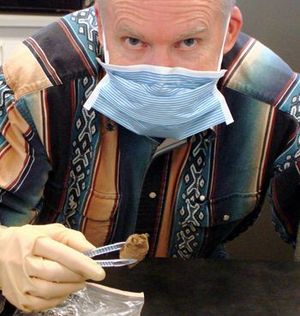Among the researchers is Dennis L. Jenkins, a senior archaeologist with the University of Oregon's Museum of Natural and Cultural History, whose summer field expeditions over two summers uncovered a variety of artifacts in caves that had caught the scientific attention of the UO's Luther Cressman in the 1930s.

|
| ©Unknown |
| Jenkins is shown holding a piece of the human caprolite (dried feces) that dates to 14,300 years ago. |
The Paisley Caves are located in the Summer Lake basin near Paisley, about 220 miles southeast of Eugene on the eastern side of the Cascade Range. The series of eight caves are westward-facing, wave-cut shelters on the highest shoreline of pluvial Lake Chewaucan, which rose and fell in periods of greater precipitation during the Pleistocene.
The team's extensively documented analyses on mitochondrial DNA -- genetic material passed on maternally -- removed from long-dried feces, known as coprolites, were published online April 3 in Science Express ahead of regular publication in the journal Science.
"The Paisley Cave material represents, to the best of my knowledge, the oldest human DNA obtained from the Americas," said Eske Willerslev, director of the Centre for Ancient Genetics at Denmark's University of Copenhagen. "Other pre-Clovis sites have been claimed, but no human DNA has been obtained, mostly because no human organic material had been recovered."
Willerslev visited the UO in 2004 to obtain samples for DNA analyses after word spread among archaeologists and anthropologists about Jenkins' discoveries. A Danish team, led by Willerslev, examined 14 coprolites -- initially using multiplex polymerase chain reaction to rapidly amplify DNA and a minisequencing assay - that were found by Jenkins and colleagues during summer field work in 2002 and 2003. The site was found 70 years ago by Cressman, who died April 4, 1994, after 35 years on the UO's anthropology faculty.
A lengthy analysis, including the collection of DNA samples from 55 UO students, supervisors, and site visitors, including 12 Danish researchers, was done to screen for modern DNA contamination. From that analysis, six coprolites containing the ancient DNA were radiocarbon dated using accelerator mass spectrometry and calendar calibrated to between 1,300 and 14,300 years ago.
"Of these, half date from the early arrival time," Jenkins said. "All six coprolites containing ancient DNA underwent additional testing at two independent labs. Three of the six also contained DNA similar to red fox, coyote or wolf." The researchers suggest that these early Americans ate the animals or that the animals urinated on the human feces during times of non-human habitation.
The DNA testing indicated that the feces belonged to Native Americans in haplogroups A2 and B2, haplogroups common in Siberia and east Asia.
Clovis culture began sometime between 13,200 and 12,900 years ago, according to a re-evaluation of Clovis evidence published in Science (Feb. 23, 2008) by Michael R. Waters of Texas A&M University and Thomas W. Stafford Jr. of Stafford Research Laboratories in Colorado.
Skeletal remains dating to Clovis culture have proven elusive, leaving researchers with little hard evidence beyond tell-tale cultural components such as the distinctive fluted Clovis points and other tools.



Reader Comments
to our Newsletter